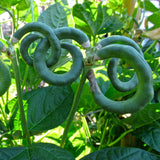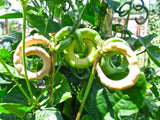Pretzel Bean
Vigna unguiculata
Pretzel-shaped pods reach to the sky atop tall, vining cowpea plants. First introduced commercially in 1893 by W. Atlee Burpee, under the name Rams Horn Bean, it was considered a curiosity. As a dry bean, it is a good and productive black-eyed pea and it fixes nitrogen into the soil.
This species was domesticated in West Africa. It was first documented in Greece in 300 B.C., and must have spread through Southern Europe from there, taking on new forms as it traveled over the centuries from village to village.
Days to maturity: 65
Seeds per pack: 30
Germination rate: 75% on 03/18/2025
Planting / harvesting notes
Direct sow black-eyed peas safely after frost, any time between late May and mid-July. This is a climbing vine crop, so it needs to be planted next to a structure or trellis. Plant 1" deep with 3" spacing, either in 1 row on each side of the net trellis or in another arrangement if using a different kind of trellis, like a pole or garden sculpture. Being a legume, it does fairly well in and adds nitrogen to poor soil.
Seed keeping notes
Black-eyed peas are self-pollinating, though it is best to isolate different varieties of V. unguiculata (including black-eyed peas, southern peas, cowpeas, and long beans) at least 20 feet, if not much farther to avoid unwanted cross-pollination. Allow beans to dry fully into a brown crispy state. This is when they are ready to harvest for seed. If necessary, lay them out to dry a little longer in their pods.







